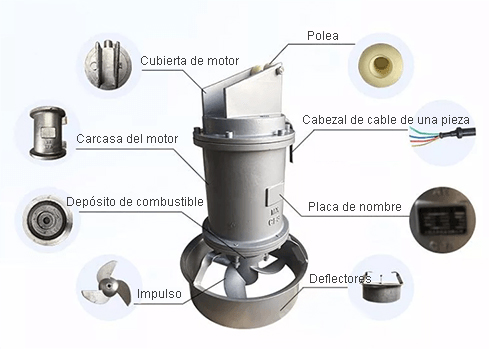 +86-15267462807
+86-15267462807
In the MBBR process, the submersible mixer works closely with the aeration system. The aeration system provides oxygen by injecting air into the biochemical pool to promote the growth and metabolism of microorganisms; while the submersible agitator fully mixes the suspended filler and sewage through stirring to improve the mass transfer efficiency. The two work together to achieve efficient sewage treatment.
Uniform Suspension of Biofilm Carriers: Prevents the carriers from settling to the bottom of the tank, ensuring optimal contact with the wastewater.
Improved Mass Transfer: Promotes the transfer of oxygen from the aeration system to the biofilm, enhancing biological activity.
Prevents Stratification: Helps to maintain a homogeneous environment within the MBBR tank, preventing dead zones where the biofilm may become inactive.
Energy Efficiency: Submersible mixers are often more energy-efficient than surface aerators, especially in larger tanks.

Propeller Mixers: These are commonly used in MBBR systems due to their ability to create a strong current and effectively suspend the biofilm carriers.
Pitched Blade Mixers: Designed for gentle mixing, these mixers are suitable for applications where excessive turbulence could damage the biofilm.
Side-Entry Mixers: These mixers are mounted on the side of the tank and are often used in larger MBBR systems.
Tank size and shape
Volume: Larger tanks require more powerful mixers to ensure adequate circulation.
Geometry: The shape of the tank can influence mixing patterns. For example, rectangular tanks may require multiple mixers for even distribution.
Flow rate
Throughput: The amount of wastewater passing through the system affects the required mixing intensity. Higher flow rates demand more powerful mixers.
Biofilm carrier density
Concentration: The density of biofilm carriers in the wastewater can impact mixing requirements. Higher densities may necessitate stronger mixing to prevent settling.
Aeration system capacity
Oxygen Transfer: The aeration system's ability to provide oxygen to the biofilm influences mixing needs. Adequate mixing ensures efficient oxygen transfer to the biofilm.
Energy efficiency requirements
Operating Costs: The energy consumption of the submersible mixer is a significant factor in operating costs. Selecting an energy-efficient model can reduce long-term expenses.